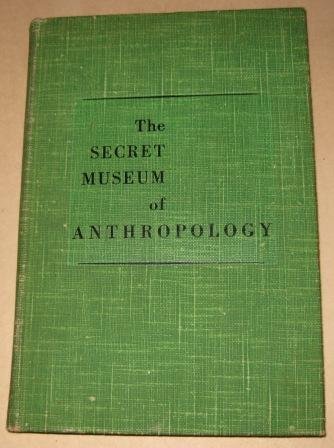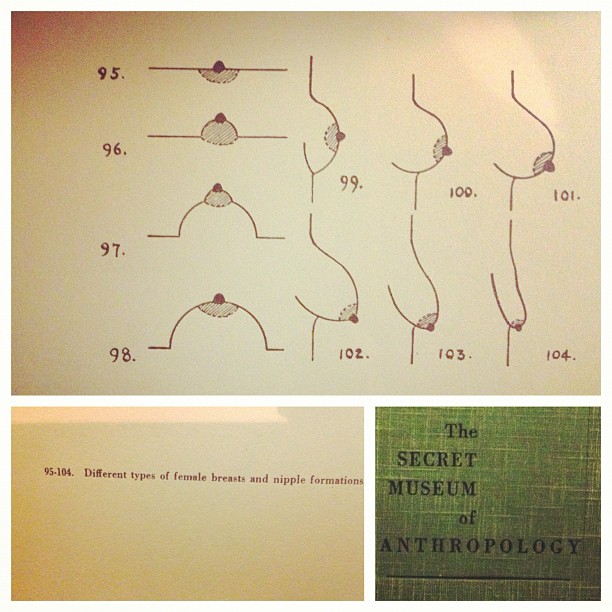
I came across a book. I’ve since played with the book, looked through it, learned about it, and digitally cut bits and pieces of it up and put them back together again as collages. I realized in speaking to others about this book, that if this book was digitized in its entirety, if in the digital format it could still be recognized as a book, or, as individual photographs, it would lose too much. We would lose too much.
The book is The Secret Museum of Anthropology (The Secret Museum). It was a privately printed book created by the American Anthropological Association in the 1930s. It is authorless and not officially recorded (the inside cover says “privately printed”). There are no marks on it indicating it was ever catalogued. It never received wide circulation, something that is built into its design as a privately published book. Despite being in an area with a plethora of Universities, there is no library around here that has it. But I do. I was able to purchase a used copy online. I know had I found this book in a library, my thoughts on it might be a little bit different. I did not though. Acquiring the book was unique experience in and of itself that helped me frame where my thoughts are headed. Thumbing through the book changed some of my thoughts on digitization.
The book is a collection of photographs that were pirated from a German book titled Das weib bei den naturvolkern : eine kulturgeschichte der primitiven frau (Primitiven frau), published in 1928. The rough translation from Google Translate is “The female in aboriginal peoples: a cultural history of the primitive woman”. Primitiven frau was digitized and is available through the Internet Archive project. The feeling of the two books, even as they contain the same photographs is completely different. The Secret Museum is a carefully edited version of the Primitiven frau, with the photographs chosen for their erotic nature. This editorial liberty limits the ability to look at the book as though it is an anthropological work rather than a pornographic one. That doesn’t mean whoever was responsible for putting this private collection together didn’t try to play as though it were real scientific anthropology. The part of the book I present/perform is the part that does just that. Part of the interactive installation piece I created is a video which can be seen below. It features a series of simple line drawings from the middle of The Secret Museum that attempt to catalog and number different types of breasts found in the photographs of the women whose photographs grace the pages of the book:
When I first received The Secret Museum, the image of the “different types of female breasts and nipple formations” made me laugh, not because it was funny, but because it made me say “of course”. The display of these breasts was the sole purpose of this book. Once I confirmed the source of the photographs, Ferdinand Freiherr von Reitzenstein, and looked up his books only to find that Primitiven frau, the book that contained these photographs originally was digitized, I was shocked. I saw flesh and bones and words instead of just flesh and crude drawings of flesh. In fact, there are more pages of words in Primitiven frau than there are of photographs and x-rays. The drawing included in The Secret Museum, appears on page 61 of Primitiven frau in a section that is 17 pages of analysis where breasts are discussed.

Instead of seeing this drawing as a numbered series that reduces the women in the book to only the drawings themselves, they exist in a larger context. While the context is problematic, at best, we are able to see the intent of Ferdinand Freiherr von Reitzenstein. Rather than simply creating a book of pornographic imagery, he did attempt to create an anthropological work on “primitive women”. Furthermore, though they are few, in addition to the photographs of nude and partially nude women Primitiven frau contains drawings of jewelry and women participating various acts, and other cultural items, such as songs with music and lyrics. There is even a photograph with fully clothed women. Additionally, the book contains an index. The Secret Museum renders the women anonymous in a way that they can never be confronted as though they existed. The index in Primitiven frau prevents this from happening, because at the very least, we know where the women we are seeing existed. Despite the problematic nature of the book, it has a wealth of information to offer us, even as we look to day in the post-post colonial age.
If The Secret Museum were to be digitized, we would lose the covertness of its creation. For me, that is the most important thing the book has to offer. The seediness of its production and purpose would be lost if the book was publicly and freely accessible. The act of having to search for the book, and find a “deal” on it, or having the book presented with the caveat that it is rare and was never published for a wide audience, the ability to touch and feel the book, to smell and see the pages and random ink colors, creates a performative experience with the book that digitization does not have. Making the book digital would erase so much of what this book does. It would allow us to lose the idea that the original audience that this book was designed for will remain forever hidden. Further, the ability to see the physical product against the digital version of what it was pirated from, on a screen where we can see page upon page of text, creates an interesting conversation around what happens when we lose text. I think seeing the physical book coupled with the digital text truly illustrates some of the issues digitization causes for certain artifacts.
It isn’t that I don’t want people to see The Secret Museum. To the contrary, the more people who can experience the book, the better we can understand, especially in the academy, whose bodies our disciplines were built upon and to what ends. It’s just that I want people to do more than see the book. I want them to experience the book. When looking through the screen at a digital version of a book, or a photo, I find it is too easy to forget that we are seeing something real that existed in a larger context that affected and affects different people differently. To lose the bodies first through a photograph and then through the digitization of a book we lose too much. The material experience of a book that can be taken out of a little bag, the method I choose to unveil the book in my installation performance, takes away the ability to show and remember how easily books like this were, and continue to be, hidden. I fear that in this digital culture of openness and access we forget that even today, there is so much that remains out of reach.
I would like to stress that I do not think the limits of digitization are a bad thing. In fact, I think they are wonderful things that open up new possibilities. The Digital’s tendency to reduce the experience of certain things is the space where I like to play. It is the space that is inherently made of breaks and new paths, breaks and paths that I am exploring in my own dissertation work. Because this is the space of my work though, I think it is important to realize and remember that there are places where digitization cannot translate, where the losses created by access and openess are too great.



